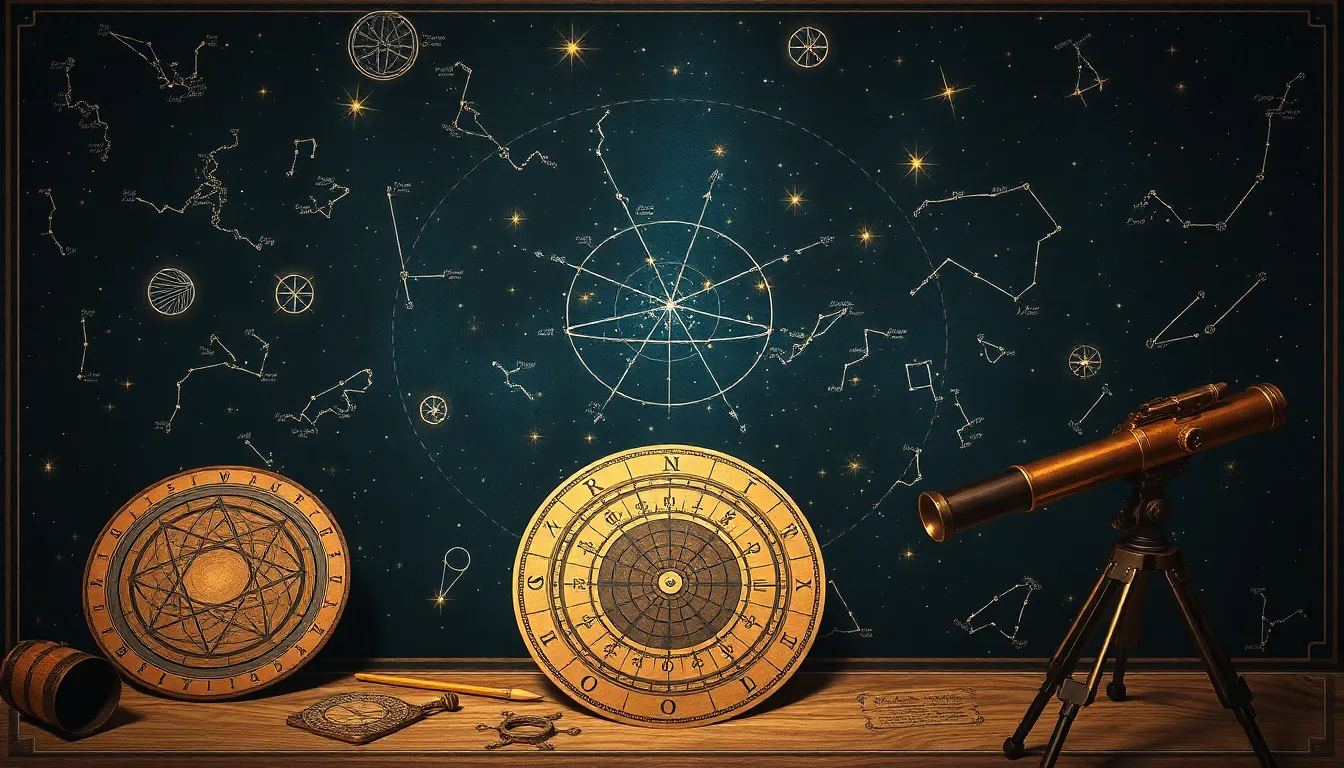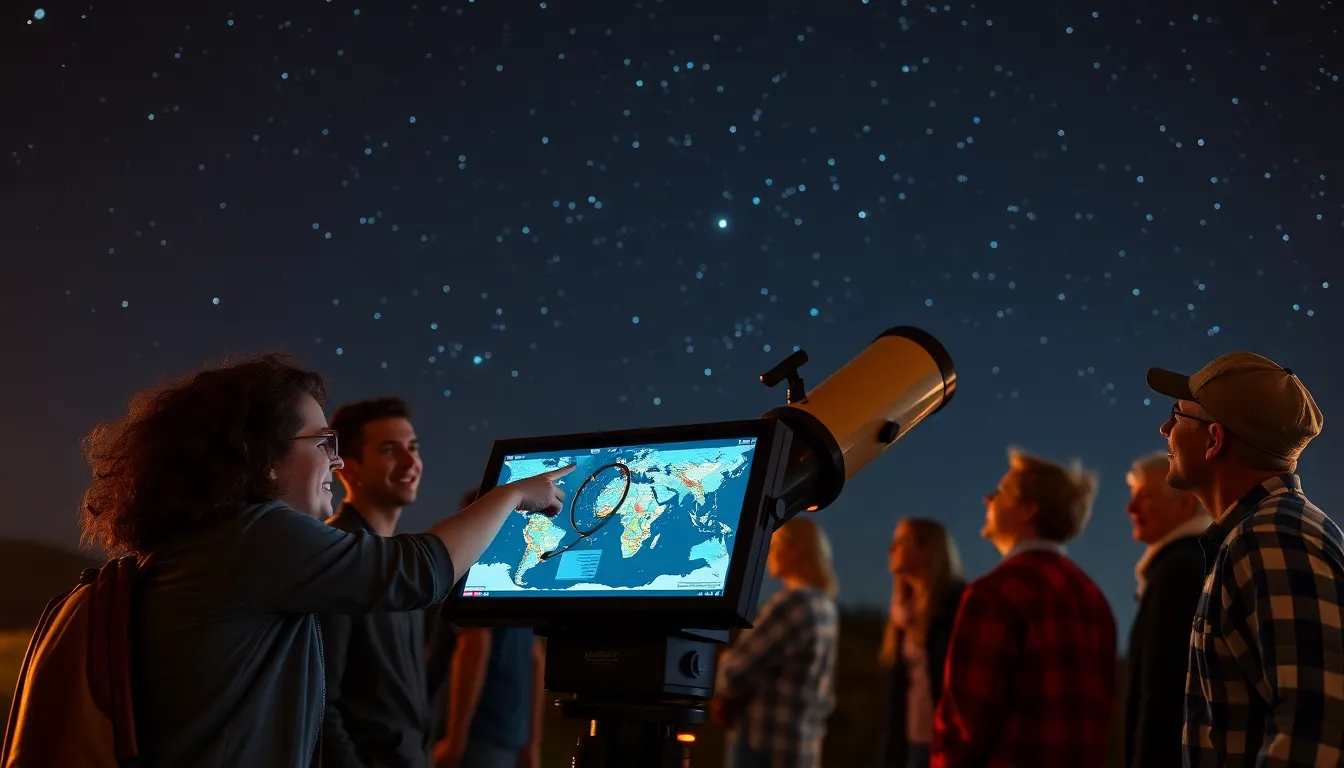In a universe bursting with stars, galaxies, and the occasional rogue asteroid, cosmic mapping emerges as the ultimate treasure map for the cosmos. Imagine navigating the vastness of space with a GPS that doesn’t just get you to the nearest coffee shop but also shows you the best spots to catch a supernova. It’s not just for astronomers; anyone with a curious mind can dive into this cosmic adventure.
Cosmic mapping isn’t just about pinpointing celestial bodies; it’s about connecting the dots in a way that even your cat would find fascinating. With cutting-edge technology and a sprinkle of imagination, cosmic cartographers are charting the unseen, revealing the mysteries of dark matter and cosmic expansion. So grab your telescope and get ready to explore the universe like never before—because who wouldn’t want to know where the nearest black hole is?
Table of Contents
ToggleOverview of Cosmic Mapping
Cosmic mapping serves as a critical tool for understanding the universe. It represents the intricate layout of celestial bodies and phenomena. Astronomers rely on advanced technologies like telescopes and satellites to create these detailed representations. Data collected includes information about galaxies, nebulae, and cosmic structures.
Cosmic cartographers analyze light from distant stars and galaxies. This analysis reveals important details about distance, composition, and movement. Understanding such parameters helps scientists decipher the universe’s expansion and the role of dark matter. Insights from cosmic mapping contribute to knowledge about the Big Bang and the universe’s evolution.
Access to cosmic maps extends beyond professional astronomers. Space enthusiasts and the general public can engage with these tools. Interactive platforms and virtual observatories allow anyone to explore the wonders of the cosmos. Curiosity-driven exploration boosts interest in astrophysics and space science.
Numerous cosmic mapping projects exist worldwide. Notable examples include the Sloan Digital Sky Survey and the European Space Agency’s Gaia mission. Each initiative gathers extensive data and creates comprehensive maps, enriching our understanding of the universe. These projects often focus on distinct aspects, such as galaxy morphology or stellar distribution.
Through cosmic mapping, humanity gains a deeper appreciation for the universe. The pursuit of knowledge transforms the perception of the cosmos from distant to familiar. Insights gained inspire further research and discovery in related fields. Cosmic mapping not only shapes scientific endeavors but also enriches the cultural narrative of humanity’s place in the universe.
Historical Context

Cosmic mapping has evolved significantly over time, originating from humanity’s intrigue with the night sky. Functioning as a bridge between ancient and modern astronomical practices, it reflects the quest to understand the universe.
Origins of Cosmic Mapping Techniques
Ancient civilizations hinted at the beginnings of cosmic mapping. Egyptians charted constellations for navigation, while Babylonians recorded celestial events meticulously. Instruments like the astrolabe emerged, allowing early astronomers to measure the position of stars accurately. As telescopes developed in the 17th century, they revolutionized cosmic mapping. Detailed observations from Galileo and Kepler advanced the understanding of planetary orbits and celestial mechanics.
Key Milestones in the Field
Numerous milestones shaped the trajectory of cosmic mapping. In the 20th century, the invention of the photographic plate facilitated capturing distant objects in the sky. The introduction of the Hubble Space Telescope in 1990 provided unprecedented clarity, enabling discoveries of far-off galaxies. Projects like the Sloan Digital Sky Survey began extensive mapping of the Milky Way, yielding a treasure trove of data. More recently, the European Space Agency’s Gaia mission has aimed to map a billion stars, enhancing knowledge about stellar positions and movements. Each milestone contributes to a richer understanding of cosmic phenomena.
The Science Behind Cosmic Mapping
Cosmic mapping combines various scientific methods and technologies to chart the universe. This approach enhances understanding of celestial bodies and their interactions.
Tools and Technologies Used
Astronomers rely on cutting-edge tools for cosmic mapping. Telescopes like the Hubble Space Telescope gather light from distant galaxies. Satellites provide real-time observations while facilitating data transmission back to Earth. These instruments help capture images and spectra that reveal important details about celestial objects. Additionally, computational software processes large quantities of collected data, forming detailed three-dimensional maps of spatial arrangements. These advanced technologies empower astronomers to analyze and interpret the structure of the universe effectively.
Methodologies for Data Collection
Multiple methodologies support cosmic data collection. Spectroscopy measures the light spectrum emitted by stars, identifying chemical compositions. Photometric techniques examine the brightness variations of celestial objects, offering insights into their distance and movement. Galaxy surveys like the Sloan Digital Sky Survey employ massive amounts of data to uncover patterns in cosmic structure. Ground and space-based observatories collaborate to ensure comprehensive coverage of the sky, allowing scientists to analyze vast regions over extended periods. These combined efforts lead to an enriched understanding of cosmic phenomena.
Applications of Cosmic Mapping
Cosmic mapping finds extensive applications across various fields, enhancing our understanding of the universe and improving navigation technology.
Astronomy and Cosmology
Astronomers utilize cosmic mapping to analyze celestial bodies and their interactions. Advanced telescopes collect light from distant stars, revealing their distances and compositions. This data influences studies on galaxy formations and cosmic phenomena. Key projects like the Sloan Digital Sky Survey create detailed maps, contributing to knowledge on the universe’s expansion.
Cosmology also benefits from cosmic mapping techniques. Understanding dark matter distribution assists scientists in unraveling the universe’s structure. Distinct patterns in maps provide insights into cosmic evolution since the Big Bang. Observing supernovae and other celestial events becomes clearer with accurate maps. Researchers translate complex data into comprehensible formats, making astronomical phenomena accessible to the general public.
Navigation and Geolocation
Cosmic mapping enhances navigation and geolocation technologies. Satellites equipped with cosmic mapping capabilities improve aerial and terrestrial positioning systems. Accurate star-based navigation systems allow pilots and navigators to pinpoint their locations using celestial references.
Global positioning systems rely on data gathered from cosmic maps to ensure precise measurements on Earth. Integration of cosmic data enhances mobile apps, guiding users effectively through varied terrains. These applications empower various industries including aviation and maritime, promoting safer travel experiences. By utilizing cosmic mapping, navigational technologies continuously evolve, refining how individuals traverse the planet.
Challenges and Limitations
Cosmic mapping presents several challenges and limitations that impact its effectiveness and accuracy.
Data Accuracy and Interpretation
Data accuracy remains a significant concern in cosmic mapping. Astronomers rely on light data collected from distant celestial bodies, but distortions from atmosphere and equipment can affect interpretation. Misinterpretations may arise from incomplete datasets, leading to potential errors in mapping cosmic structures. Challenges also occur when analyzing spectral data, as overlapping signals can conceal important information. Furthermore, varying methodologies among researchers can lead to inconsistency in results, complicating collaborative efforts. Addressing these issues demands ongoing refinement of data collection techniques and analysis models.
Technological Constraints
Technological constraints pose a challenge to cosmic mapping endeavors. Limited resolution of current telescopes affects the clarity of observed celestial phenomena. Hardware limitations inhibit the amount of data that can be processed effectively. Satellite technology also faces restrictions due to budget constraints and availability of suitable instruments, which may hinder extensive mapping projects. Furthermore, reliance on specific wavelengths for observations can restrict visibility of certain cosmic events. Advancements in technology are essential for overcoming these constraints and expanding the capabilities of cosmic mapping efforts.
Future of Cosmic Mapping
Exciting advancements shape the future of cosmic mapping. Innovations in technology enhance the ability to capture and interpret cosmic data.
Emerging Innovations
Artificial intelligence plays a significant role in accelerating analysis. Machine learning algorithms sift through vast datasets, uncovering patterns previously undetectable. Next-generation telescopes, such as the James Webb Space Telescope, promise to deliver unprecedented detail about distant galaxies. These telescopes will complement existing missions, expanding knowledge of cosmic phenomena. Engaging tools like augmented reality applications invite users to interact with cosmic maps. Innovative collaborative platforms enable scientists to share findings in real time, fostering a global community of cosmic researchers.
Potential Impacts on Science
Understanding cosmic phenomena advances significantly with improved mapping techniques. Enhanced data accuracy leads to better knowledge of dark matter and galaxy formations. Scientists can refine models of cosmic evolution, addressing critical questions about the universe’s origins. In astronomy, emerging insights aid in the discovery of exoplanets with characteristics that support life. Collaboration among diverse scientific disciplines benefits from cosmic mapping, engaging fields such as physics, engineering, and computer science. Ultimately, these advancements provide a clearer picture of the universe, inspiring curiosity and further exploration.
Cosmic mapping opens up a universe of possibilities for exploration and understanding. As technology advances, the ability to chart the cosmos becomes more refined and accessible. This not only enhances scientific research but also invites enthusiasts to engage with the wonders of space.
The future of cosmic mapping looks promising with innovations like artificial intelligence and next-generation telescopes paving the way for deeper insights. These developments will continue to unravel the mysteries of dark matter and galaxy formations while fostering a collaborative spirit among scientists.
Ultimately, cosmic mapping transforms the vastness of space into a navigable landscape, inspiring curiosity and encouraging exploration beyond our planet.




